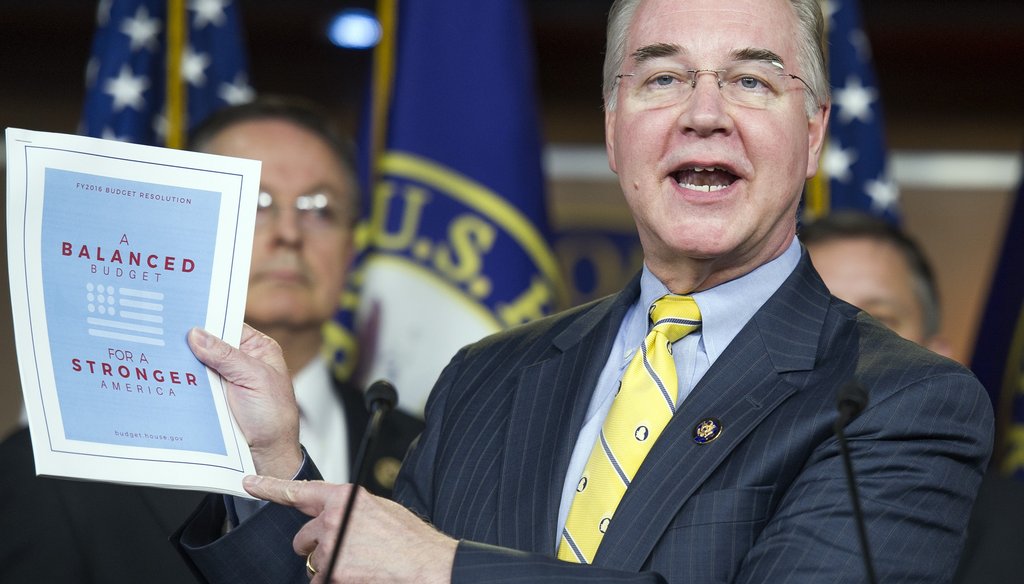

Our only agenda is to publish the truth so you can be an informed participant in democracy.
We need your help.


House Budget Committee Chairman Rep. Tom Price, R-Roswell, holds up his 2016 budget blueprint. File photo by the Associated Press
Before Georgia Rep. Tom Price of Roswell in metro Atlanta, was nominated for a position in Donald Trump’s cabinet, he was in charge of the House Budget Committee. The physician-turned-congressman has been an outspoken critic of Obamacare -- and Washington gridlock. Price will continue to be the chairman until he is confirmed for a Cabinet position by the Senate.
At a recent event in Washington D.C. at the Brookings Institution, Trump’s pick for Secretary of Health and Human Services spoke on the effectiveness, or lack thereof, of the annual government funding process.
Price said, "In the last five years only one out of 60 -- one out of 60 -- appropriations bills has been passed on time before the end of the fiscal year."
Congress often passes spending bills belatedly. But we wondered, do so few really get passed on time?
PolitiFact Georgia decided to take a look.
Background
For some background, we looked to who is responsible for what when it comes to the budget.
The Budget Committee, which Price has chaired since 2015 after taking over from now-Speaker Paul Ryan, is made up of five members from the Committee on Ways and Means, five members from the Committee on Appropriations, and one member from the Committee on Rules.
The committee is responsible for developing the annual budget resolution, which is what kicks off the budget process by setting the top line number for appropriations. Basically, it sets the ceiling for how much money the 12 annual appropriations bills can collectively spend.
Appropriations bills start in the House. Both the House and Senate come up with their own versions of the bills. The chambers can pass bills individually, and regularly do, but the bills must match before being sent to the president. To start the process, the House and Senate Appropriations Committees take the top line number set by the budget committee, divvy it among the 12 bills and then write bills to those numbers.
For the last several years, Congress has been prone to passing continuing resolutions that extend pre-existing appropriations, and omnibus spending bills that pack many smaller, regular appropriations bills into one, instead of new, individual bills each fiscal year.
Additionally, only one-third of federal spending is done through annual appropriations bills approved by Congress. The other two-thirds is mandatory spending on entitlements such as Social Security and Medicare. But mandatory spending appropriations aren’t permanent -- Congress can make changes in the law that alter spending within mandatory programs.
One lone bill
We found that this bill, the lone appropriations bill passed before the end of the fiscal year that Price speaks of, does, in fact, stand alone.
We reached out to Price’s spokesperson Ryan Murphy. He sent us a compilation of background information by some federal sources.
Earlier this year, Congress passed an appropriations bill on military construction, which was signed into law by President Obama on Sept. 29, two days before the start of the 2017 fiscal year.
According to a number of bills listed on Congress.gov, the military construction bill passed in September is the only full, line-by-line appropriations bill that has been enacted before Oct. 1 in the last five years. (Although continuing resolutions are technically appropriations bills and pass before the Oct. 1 deadline, this is the only full appropriations bill with new funding that was passed.)
But some of the issue with Price’s statement comes from his choice of words. The House and Senate pass bills, but those versions must be reconciled and passed again before they can be enacted after being signed into law by the president. The Senate website says, "Once legislation has passed both chambers of Congress in identical form, been signed into law by the president, become law without his signature, or passed over his veto, the legislation is enacted."
Our ruling
Health secretary nominee Tom Price said, "In the last five years only one out of 60 -- one out of 60 -- appropriations bills has been passed on time before the end of the fiscal year."
And that’s basically true. Congress has turned to omnibus spending bills and continuing resolutions to fund the government for the last couple of years, which differ from full appropriations bills.
However, in the last five years, appropriations bills were passed by individual chambers before the end of the fiscal year, they just weren’t matched by the other chamber or reconciled. Even then, all but one was signed into law by the president (and enacted) after Oct. 1.
We rate his statement Mostly True.
Email with Ryan Murphy, spokesman for Rep. Price
2017 appropriations (Congress.gov)
2016 appropriations (Congress.gov)
2015 appropriations (Congress.gov)
In a world of wild talk and fake news, help us stand up for the facts.
